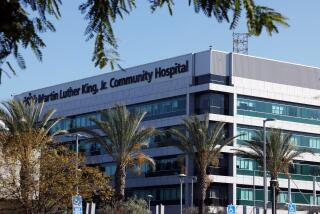Westworld Sows Seeds of Success in the Country
CUSTER, S.D. — About 20 miles southwest of Mt. Rushmore National Monument, barber Mickie Nelson charges $4 for a trim and nothing for an earful of local news.
While Nelson may not have any problems filling the one chair in his tiny shop, the nearby Harney Theatre, named after South Dakota’s tallest peak, is closed for lack of business in this Black Hills town with a population of just 2,000.
But even if townsfolk have to drive 40 miles to Rapid City or Hot Springs for a movie, they don’t have to go farther than Custer Community Hospital for state-of-the-art medical care. Custer’s cozy, brick, 16-bed hospital has a new $130,000, computerized sonography machine.
The “Acuson” ultrasound machine is a symbol of the tremendous improvement in local health care that city officials attribute to Westworld Community Healthcare, a fast-growing, aggressive Orange County company that operates 32 rural medical-care facilities in 12 states.
Westworld’s approach to bringing high-quality health care to rural communities has been a prescription for success. Unlike larger companies that operate both large and small hospitals, Westworld’s sole mission is to serve rural America.
It targets communities served by one small, usually ailing hospital where residents have abandoned the local facility because of what they perceived to be second-rate care. The company attempts to form a close partnership with local government as a means of ensuring community support.
Typically, Westworld asks residents to determine exactly what kind of health-care services they need and whether Westworld should be granted the local monopoly it seeks.
If the community says yes, Westworld makes a long-term financial commitment to buy necessary equipment and recruit professionals best suited for a rural life style.
When Westworld assumed the management of Custer Community Hospital in September, 1982, the city-owned facility was losing about $200,000 a year and residents were going elsewhere because they were unhappy with the quality of services. All too often doctors would stay just a few months, frustrated with the slow pace and modest income.
Today, with new staff and up-to-date surgical and lab equipment, Custer’s newly modernized hospital is profitable, has an alcoholism treatment program, three full-time family practitioners, a radiologist, a psychiatrist, a psychologist and a physical therapist. The doctors also serve three nearby satellite clinics.
Has Air Ambulances
To transport patients who need more specialized services, Westworld recently built a hangar in Custer to house planes owned by its Medical Air Rescue Co. (MARC) subsidiary. Based in Rapid City, MARC’s air ambulances fly patients to and from hospitals in Denver, Rochester, Minn., and elsewhere when they cannot be flown commercially. MARC also ferries Westworld doctors, therapists and executives from town to town.
“Mike Dunn (Westworld’s chairman and chief executive) has done everything he said he was going to do to improve health care,” said Gordon Dretsch, a retired bank president, city councilman and hospital board member who has lived in Custer since 1946.
Dunn, 40, sticks with a simple strategy. He has developed a list of 2,465 communities with 15,000 or fewer residents served by one small hospital. Working from that list, or prompted by calls from local officials, Dunn and his management team decide where to move next. After meeting with local officials, Westworld asks a community group such as the chamber of commerce to sponsor a town meeting. There, the community and company look each other over. “We don’t want to come into a hostile environment,” Dunn said. “We would drown in red ink.”
If a community wants Westworld to provide services, the company generally signs a long-term lease, typically for 30 years, to upgrade and manage existing health-care facilities. Westworld has purchased only four of its 32 facilities, preferring to lease them from the communities they serve because it allows the community to retain control over its health-care services, Dunn said.
Psychological Benefits
He said the benefits of leasing are more psychological than financial because “in some cases, we could have bought the building for a dollar.”
Dunn, a stocky, gray-haired man with a crew cut, says Westworld’s goal is to add at least eight or nine facilities a year. So far this year, Westworld has added eight and expects to add four more by year-end.
The success of Dunn’s strategy is evident. In calendar 1984, Westworld’s profits jumped to $1.8 million from $279,000 the prior year, and revenues nearly tripled to $50.5 million from $17.3 million.
For the first quarter ended March 31, net income jumped 145% to $892,000 from $364,000 in 1984’s first quarter. Revenues climbed 138% to $23.6 million from $9.9 million a year earlier.
To keep pace, Westworld, which employs 2,500 nationwide, recently moved the 90 people at its headquarters to a new 41,000-square-foot corporate building in the Orange County community of Lake Forest. The facility includes a training center for hospital administrators, program directors and other personnel.
Westworld went public a year ago with an initial offering of 1.25 million shares at $9.50 a share. The offering netted $10.4 million, allowing the company to pay down debts and add to its working capital. In early April, Westworld raised an additional $28 million by selling notes. Dunn said those funds will be used for new construction, equipment and working capital.
Westworld stock, which sold at a high of $14.25 per share in the fourth quarter of 1984, was trading at about $29 per share on the over-the-counter market last week before a 2-for-1 stock split last Tuesday. The stock closed Friday at $14.50.
Kept Its Promises
Health-care industry analysts say one reason Westworld shares have performed so well is that the company has kept its promises of fast growth and profits.
“Other health-care companies have been trying to do this (serve rural America), but none have been doing as well as Westworld,” said Randy Huyser, an analyst with Montgomery Securities in San Francisco.
Huyser said that several small companies are starting out in the rural health-care business but that they will be forced to compete with Westworld’s impressive track record.
Westworld executives say they rely on their local hospital administrators to provide a constant link to the community. Charles Duscha, Custer’s hospital administrator, said the town has responded to Westworld’s efforts by increasing the occupancy rate from about 30% to 50% and seeking out Westworld’s doctors and nurses rather than driving to Rapid City.
In calendar 1984, Custer Community Hospital and its three satellite clinics generated $2.3 million in revenues and a profit of $212,000, compared to revenues of $1.5 million and net income of $56,000 in 1983. Westworld also invested $1.5 million in assets in Custer’s health facility operations during 1984.
New Insurance Plan
Custer is also the headquarters of Westworld’s new prepaid health insurance plan, WEstCARE. Westworld hopes to sign up 125,000 members in the small towns it serves across the country.
Although some residents still seek out specialists in Rapid City, many more are staying close to home for routine health care. The hospital emergency room is kept busy with injured workers from nearby sawmills and mountain climbers.
Duscha said Custer’s quality of care compares with that of hospitals in more populated areas. And because the company is bringing in top-quality professionals, “communities that once settled for a doctor who was just a warm body don’t have to anymore.”
“As an employee, I was extremely impressed with the changes there,” said Helen Flora, a recently retired Custer Community Hospital nurse, who owns Flora’s Western Wear clothing and gift shop. “Westworld has made tremendous strides since they got here.”
Not only has the quality of equipment improved and made nursing easier, she said, but the new doctors hired have also upgraded the quality of care.
On Tuesdays and Fridays, Custer’s radiologist, G. Robert Hanson, and physical therapist, Jeff Lange, see patients in Sundance, Wyo. On a recent Tuesday morning, Hanson, Lange and two visitors boarded one of MARC’s six-seat Cessnas for the 30-minute flight over the densely wooded Black Hills on the way to Wyoming.
Visitors to the sleepy ranching town, which celebrates its 100th birthday this year, are greeted by a “Welcome 2 Sundance” sign strung across Main Street.
Dramatic Improvement
Crook County officials said Westworld’s recruiting efforts and investment in new equipment and services have dramatically improved the town’s health-care services in the last three years. The next step is a 24-bed skilled nursing home scheduled to open next year adjacent to Crook County Memorial Hospital.
“We’ve been talking about building a nursing home for 25 years, but we never got the money,” said Don Gose, chairman of the county Board of Supervisors, during a break in a recent meeting. “You don’t realize how hard it is to come by $1.1 million in Crook County. This is by far the largest project in the county.” To put the project in perspective, Gose said the entire fiscal 1985 county budget is only $2.3 million.
Westworld committed about $500,000 toward the nursing home and agreed to make up any operating deficits. Westworld will operate the county-owned nursing facility. Last year, Westworld invested $1.7 million in Crook County’s hospital and four clinics, which serve about 6,200 residents.
Not every Westworld hospital is profitable. The Crook County operations lost $212,000 on revenues of $2.2 million in 1984, compared to a loss of $75,000 on revenues of $2.1 million in 1983. Dunn said a weak local economy and expenses related to improving services led to the increased loss, but he is optimistic that the town’s fortunes will improve.
“The economy has been terrible,” said Howard Allen, co-publisher of the Sundance Times. “Energy went to hell, and, lately, the weather has been bad for ranchers and farmers.” Dunn, who spends about 12 days each month visiting Westworld’s facilities, recalls with pride the wintry day when 150 of the 700 residents of Bowdle, S.D., gathered for a meeting with Westworld officials. “When a town turns out like that, we say this is going to be a winner because people care.”
More to Read
Inside the business of entertainment
The Wide Shot brings you news, analysis and insights on everything from streaming wars to production — and what it all means for the future.
You may occasionally receive promotional content from the Los Angeles Times.










